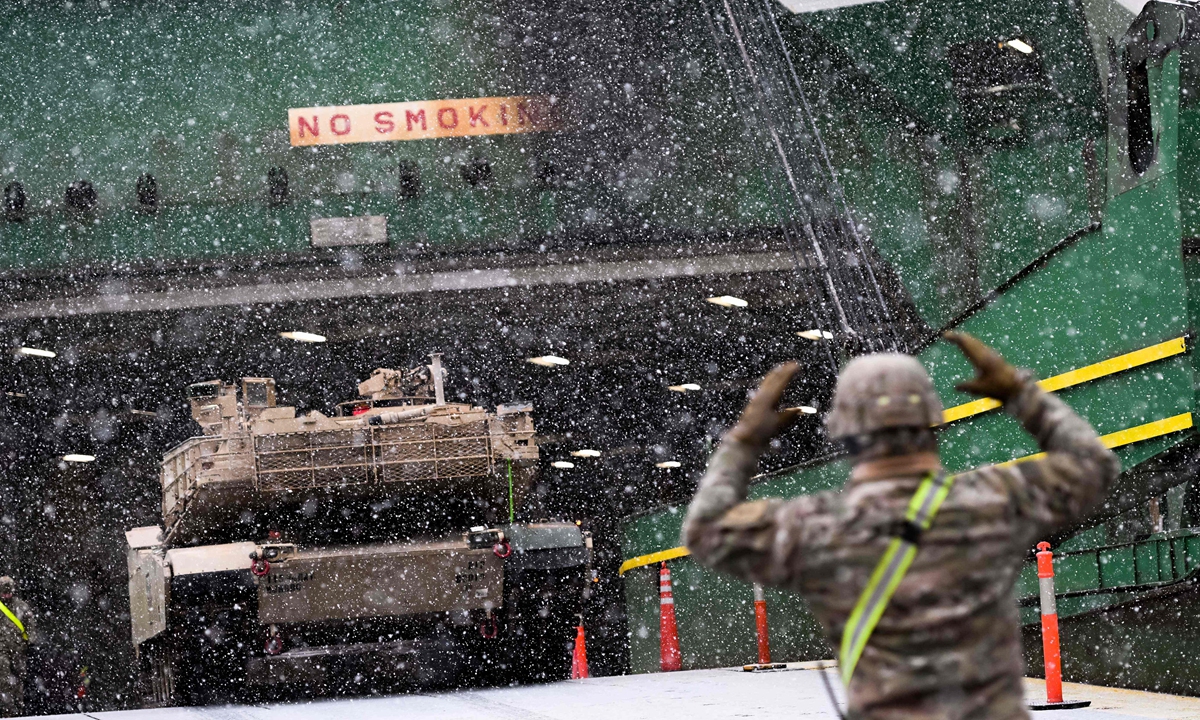
A US Army soldier signals the way to a M1A2 Abrams battle tank that will be used for military exercises by the 2nd Armored Brigade Combat Team, at the Baltic Container Terminal in Gdynia on December 3, 2022. The military equipment arrived in Poland as part of the Operation Atlantic Resolve, augmenting the air, ground and naval presence along the Eastern flank of the NATO. Photo: VCG
The first batch of US-made M1A2T tanks sold to the Taiwan island reportedly arrived in Taipei on Sunday following the arrival of accessory equipment of the tanks in Kaohsiung on Friday, but a military expert from Chinese mainland said the tanks, trumpeted by media on the island as "the most powerful combat vehicle on the ground," are too bulky and heavy for island combat and will only serve as easy targets for drones and attack helicopters.
Following the arrival of the first batch of the M1A2T tanks at Taipei Port on Sunday, they are scheduled to be transported to Hsinchu from Sunday night to Monday morning. These tanks will be deployed to the Taiwan army's training center in Hsinchu, in preparation for training after the Spring Festival next year, according to Taiwan media outlet Liberty Times Net on Sunday.
It was originally reported that the tanks arrived in Kaohsiung port on Friday, but it was confirmed that it was the arrival of the tanks' accessory equipment, Liberty Times Net reported.
The US State Department announced in July 2019 the sale of 108 M1A2 tanks and related support to Taiwan island. As per the information unveiled in the public budget of the defense authority on the island of Taiwan, its army is scheduled to receive 38, 42 and 28 vehicles in three batches in three years from 2024 to 2026, and the M1A2T is a customized version for the island of Taiwan, Liberty Times Net reported.
Liberty Times Net dubbed the M1A2T "the most powerful combat vehicle on the ground," claiming that it is equipped with "a lethal 120mm gun, highly protective composite armor, and exceptional mobility and combat efficiency."
However, mainland military expert Wei Dongxu told the Global Times that the M1A2 is not a good choice, as the island is densely covered with water networks, while the M1A2 is over 60 tons in weight, posing great limitations on mobility and deployment.
In addition, the M1A2 uses a highly fuel-consuming gas turbine, arguably a type of tank with complicated maintenance and upkeep needs, said Wei. Even if the M1A2 is considered advanced, it will be shattered into parts when confronted with aviation forces such as attack helicopters armed with a large number of anti-tank missiles, Wei noted.
The M1A1 tanks, in the same family as the M1A2T, failed to perform effectively in the Russia-Ukraine conflict.
Ukraine has sidelined US-provided Abrams M1A1 battle tanks for now in its fight against Russia, in part because Russian drone warfare has made it too difficult for them to operate without detection or coming under attack, AP reported in April, citing two US military officials.
The M1 Abrams has suffered heavy losses on Ukrainian soil, with many reportedly destroyed due to advanced Russian weaponry like the Kornet anti-tank missile, US media outlet the National Interest reported in September.
Wang Ya'nan, chief editor of the Beijing-based Aerospace Knowledge magazine, told the Global Times on Sunday that roles and survivability of tanks face serious challenges in modern land combat, as they face unprecedented threats from drones.
If the Taiwan authorities believe that tanks can bring a significant boost to its military capabilities, their hopes are too high, Wang said. "The time has changed, and the combat patterns of the past are no more," he said.




